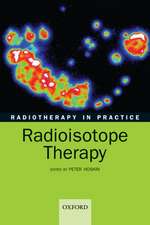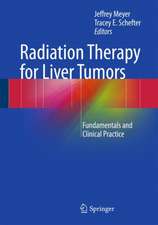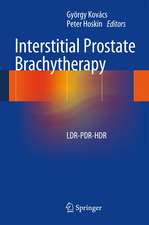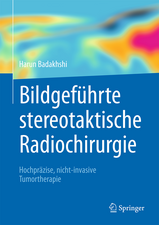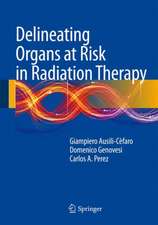Hypofractionated and Stereotactic Radiation Therapy: A Practical Guide
Editat de Orit Kaidar-Person, Ronald Chenen Limba Engleză Paperback – 15 aug 2018
| Toate formatele și edițiile | Preț | Express |
|---|---|---|
| Paperback (1) | 801.42 lei 38-44 zile | |
| Springer International Publishing – 15 aug 2018 | 801.42 lei 38-44 zile | |
| Hardback (1) | 1123.13 lei 3-5 săpt. | |
| Springer International Publishing – 5 oct 2024 | 1123.13 lei 3-5 săpt. |
Preț: 801.42 lei
Preț vechi: 843.60 lei
-5% Nou
Puncte Express: 1202
Preț estimativ în valută:
153.37€ • 159.53$ • 126.62£
153.37€ • 159.53$ • 126.62£
Carte tipărită la comandă
Livrare economică 10-16 aprilie
Preluare comenzi: 021 569.72.76
Specificații
ISBN-13: 9783319928005
ISBN-10: 3319928007
Pagini: 424
Ilustrații: XXVII, 406 p. 51 illus., 40 illus. in color.
Dimensiuni: 155 x 235 x 34 mm
Greutate: 0.82 kg
Ediția:1st ed. 2018
Editura: Springer International Publishing
Colecția Springer
Locul publicării:Cham, Switzerland
ISBN-10: 3319928007
Pagini: 424
Ilustrații: XXVII, 406 p. 51 illus., 40 illus. in color.
Dimensiuni: 155 x 235 x 34 mm
Greutate: 0.82 kg
Ediția:1st ed. 2018
Editura: Springer International Publishing
Colecția Springer
Locul publicării:Cham, Switzerland
Cuprins
Biological Rationale for Hypofractionated Radiation Therapy.- Modern Physics and Technological Developments for Delivery of Hypofractionated Radiation Therapy.- Prostate Cancer.- Breast Cancer.- Lung Cancer.- Skin Cancer.- Central Nervous System Tumors.- Gastrointestinal Cancer.- Gynecologic Cancer.- Pediatric Cancer.- Palliation.
Recenzii
“This book is an excellent review of the literature supporting the usage of hypofractionated radiotherapy. It is well organized and presents in tabular format important indications for hypofractionated radiotherapy. Of the readership of Neurosurgery, CNS radiation oncologists, brain and spine tumor neurosurgeons, and radiation oncology residents would particularly benefit from the expertise provided in this review. Community radiation oncologists would also find this review quite useful given the relative novelty of hypofractionated radiotherapy … .” (Michael Chan, Neurosurgery, Vol. 85 (3), September, 2019)
“The book provides a history of radiobiology and hypofractionation, giving a concise background of how both radiation therapy and the understandings of radiobiology have co-evolved before discussing further the physics behind hypofractionation and SRS/SBRT. … the book is very well presented and is designed to be a ‘handbook’ that is both relevant and accessible, with current information enabling the reader to locate and utilise practical and supported data.” (Craig Jones, RAD Magazine, March, 2019)
“The book provides a history of radiobiology and hypofractionation, giving a concise background of how both radiation therapy and the understandings of radiobiology have co-evolved before discussing further the physics behind hypofractionation and SRS/SBRT. … the book is very well presented and is designed to be a ‘handbook’ that is both relevant and accessible, with current information enabling the reader to locate and utilise practical and supported data.” (Craig Jones, RAD Magazine, March, 2019)
Notă biografică
Orit Kaidar-Person, Department of Radiation Oncology,University of North Carolina School of Medicine, Chapel Hill, North Carolina,USA
Oncology Institute, Radiation Oncology and Neuro-Oncology Unit,Rambam Medical Center, Haifa, Israel
Textul de pe ultima copertă
This handbook summarizes the data and techniques for hypofractionation and stereotactic radiation in a clinically-accessible way. Hypofractionated radiation therapy, which consists of larger-dose radiation treatments that are given over a shorter time period compared to conventional radiation fraction sizes, is used to treat a variety of cancers, including prostate, breast, lung, and colorectal. Conventional radiation therapy and hypofractionated radiation therapy have different effectiveness rates for cancer treatment and have different impacts on normal tissues in terms of causing toxicity. There is a significant and growing body of literature on the use of different dosing regimens to treat a variety of cancers and radiation oncologists need to keep up with the various dosing schedules, the effect of each regimen on cancer control in different cancers, and how the different schedules affect each organ in terms of toxicity. The book thus provides concise information ranging from commonly-used dose-fractionation schemes for hypofractionated and stereotactic body radiotherapy to simulation and treatment specifications to published safety and efficacy data. Chapters additionally examine the biological rationales for the efficacy of hypofractionated radiation; present clinical studies that demonstrate the efficacy and safety of hypofractionated radiation treatment in a variety of cancers; and describe the advances in technology that have allowed hypofractionated radiation to be safely given. This is an ideal guide for radiation oncology clinicians and trainees.
Caracteristici
Easily accessible handbook that summarizes published data on efficacy of different dose fractionations and the dose/volume/outcome data for relevant normal tissues and organs under different fractionation schemes Presents biological rationale and clinical data for use of hypofractionated radiation therapy in treatment of various cancers Serves as valuable resource through analysis of different dosing schedules used in hypofractionated radiation therapy, effect of each regimen on cancer control, and effects of therapeutic schedules on normal tissues and organs

